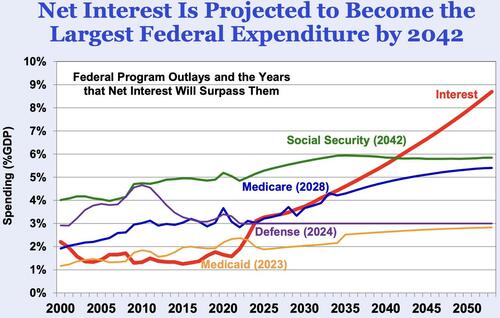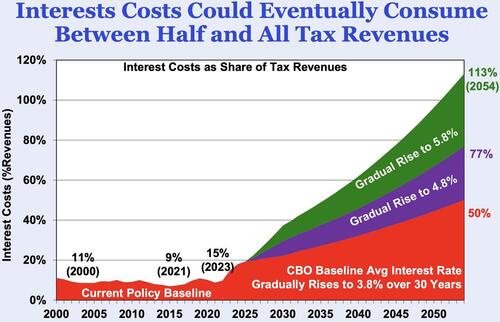
Дядя Сэм должен 37 триллионов долларов? Это намного хуже, чем это
Виа Брайан МакГлинчи Звёздные реальности
Когда его спросили, как далеко правительство США зашло в красной зоне, он ответил: Многие финансово сознательные Американцы скажут вам, что государственный долг достиг 37 триллионов долларов. Как бы ни была печальна эта официальная цифра, реальная финансовая ситуация в Америке еще хуже. намного хуже. Согласно едва обнародованному отчету Казначейства, Общая сумма обязательств дяди Сэма составляет более 151 триллиона долларов.
Это огромное несоответствие вытекает из того, что Федеральное правительство не придерживается тех же стандартов бухгалтерского учета, которые оно налагает на предприятия.. Вместо того, чтобы использовать учет начислений, который учитывает расходы, когда они понесенный Наши вашингтонские повелители используют простой учет наличных денег, только когда они признают расходы. оплачиваемый. В результате дискурс о федеральных обязательствах фокусируется исключительно на национальном долге, включающем казначейские векселя, банкноты и облигации.
Раз в год, однако, неясный отчет дает более точную версию баланса дяди Сэма. Несмотря на то, что журналисты и государственные чиновники почти не обращают на него внимания, Министерство финансов обязано представлять Конгрессу ежегодный отчет с подробным описанием финансового состояния правительства.. Крайне важно, что закон 1994 года, обязывающий этот отчет, предписывает, чтобы он отражал «необеспеченные обязательства», то есть обязательства, принятые без каких-либо выделенных активов или потоков доходов, чтобы гарантировать, что они будут сохранены.
 Член палаты представителей Томас Масси, который имеет две степени MIT, спроектировал и запрограммировал штифт, который отображает растущий государственный долг в режиме реального времени. (Фото: Алекс Вонг / Getty Images)
Член палаты представителей Томас Масси, который имеет две степени MIT, спроектировал и запрограммировал штифт, который отображает растущий государственный долг в режиме реального времени. (Фото: Алекс Вонг / Getty Images)Одной из более крупных категорий этих необеспеченных обязательств являются будущие льготы для федеральных служащих и ветеранов. Только в конце 2024 финансового года это обязательство составило 15 триллионов долларов. Однако, Самые большие необеспеченные обязательства возникают из обязательств по социальному страхованию Америки В первую очередь, социальное обеспечение и медицинская помощь. В конце финансового года эти обязательства составили 105,8 триллиона долларов.
Укладывая эти и другие необеспеченные обязательства в дополнение к государственному государственному долгу и другим обязательствам, вы получаете в общей сложности 151,3 триллиона долларов в конце 2024 финансового года. Компенсируя это примерно на 7,9 триллиона долларов в коммерческих активах правительства США, включая недвижимость, заводы, оборудование и предполагаемые золотые запасы, Анализ Just Facts оценивает дядю Сэма в 143 триллиона долларов.
В статье, опубликованной в Институте Хартленда, президент Just Facts Джеймс Агрести (James Agresti) выразил эту почти непостижимую общую точку зрения: 143 триллиона долларов составляют 85% чистого богатства, накопленного американцами с момента основания страны.По оценкам Федеральной резервной системы, он составляет 169 триллионов долларов. Это включает все их активы в сбережения, недвижимость, корпоративные акции, частные предприятия и даже потребительские товары длительного пользования, такие как автомобили и мебель. "
Эти цифры отражают позицию правительства 30 сентября 2024 года. Они не только значительно ухудшились за прошедшие месяцы, они ухудшаются с головокружительной скоростью, даже когда вы читаете это: Даже не считая необеспеченных обязательств, которые представляют большую часть проблемы, Только государственный долг растет примерно на 156 миллионов долларов в час.
Споры о бюджете нас не спасут. Дебаты в Конгрессе, как правило, сосредоточены на дискреционных расходах - расходах, которые требуют голосования Конгресса во время процесса ассигнований. Однако, Устойчивый шаг Америки к неплатежеспособности обусловлен так называемыми обязательными расходами.Это связано с ранее принятыми законами.
Что может быть самым зловещим признаком того, что правительство находится на пути автопилота к катастрофе. Доля общих федеральных расходов, обусловленных обязательными расходами, с 1965 года более чем удвоилась. — с 34% до 73% в 2024 году. Это было на 71% всего двумя годами ранее, в 2022 году.
 Расходы, налоги и дефициты Манхэттенского института: Книга чартов
Расходы, налоги и дефициты Манхэттенского института: Книга чартовДвумя крупнейшими примерами обязательных расходов являются социальное обеспечение и медицинская помощь. Эти программы по старости сейчас находятся в пределах видимости кризиса, о котором предупреждали целое поколение.: Согласно последнему отчету их программных попечителей, трастовые фонды социального обеспечения и Medicare в настоящее время находятся всего в семи годах от банкротства.
В то время как федеральное правительство требует, чтобы пенсионные планы частного сектора поддерживали активы, равные текущей стоимости будущих обязательств, федеральное правительство освобождает себя от предоставления той же безопасности гражданам, которую оно принуждает в программу социального обеспечения. Вопреки мифологии о том, что налоги на заработную плату помещаются на отдельные «счета», предназначенные для нашей будущей выгоды, эти деньги немедленно раздаются другим людям. которые уже достигли фазы получения выгоды, поэтому социальное обеспечение можно разумно сравнить со схемой Понци.
Потому что соотношение налогоплательщиков к бенефициарам неуклонно снижается — с 5,1 в 1960 году до 2,7 в 2023 году. Выплаты по социальному обеспечению превысили доходы за последние 15 лет. В результате в 2033 году иссякнут целевые фонды социального обеспечения и Medicare. В соответствии с законом, регулирующим социальное обеспечение, выплаты в этом году будут ограничены программными доходами, что приведет к внезапному сокращению выплат на 23%.
Несмотря на то, что это представляет собой политическую бомбу замедленного действия, не ожидайте никакой срочности в ее разрядке. Восьмилетний обратный отсчет невелик, но он все еще находится за рамками следующих выборов, которые определяют действия выборных должностных лиц. Эти Политики знают, что любой, кто предложит давно назревшее переосмысление социального обеспечения и Medicare, будет оппортунистически обвинен в «нападении» на программы.. Однако, когда кризис, наконец, на их коленях, не удивляйтесь, если часть их решения заключается в том, чтобы занять деньги, чтобы поддержать выплаты.
Есть еще один ключевой компонент обязательных расходов, который не учитывается в государственном долге: процентные платежи. по долгам, выпущенным для покрытия прошлых и текущих расходов. В общей сложности социальные программы и проценты по государственному долгу, которые в основном связаны с социальными программами, составляют 75% всех федеральных расходов.
Процентные платежи также представляют собой постоянно растущую долю общих расходов и составят почти 1 триллион долларов в этом году. В течение 10 лет проценты, по прогнозам, достигнут $2 трлн.Это примерно равно всему дефициту 2025 года. В прошлом году была отмечена мрачная веха, поскольку процентные расходы превысили расходы на оборону и Medicare.
 Расходы, налоги и дефициты Манхэттенского института: Книга чартов
Расходы, налоги и дефициты Манхэттенского института: Книга чартовТекущие прогнозы показывают, что к 2042 году социальные выплаты станут крупнейшими, но не удивляйтесь, если эта веха не наступит раньше. Правительство уже спускается в порочный круг, в котором растущий долг США заставляет покупателей этого долга требовать более высоких процентных ставок в качестве компенсации за растущий риск инфляции и / или дефолта; — с этими более высокими ставками, создающими большие процентные выплаты и еще больше долгов.
Помимо обязательных и дискреционных, и финансируемых и не финансируемых, Существует еще более важная, но менее обсуждаемая классификация расходов. Это в самом сердце американского марша к финансовой катастрофе. Конституционный против неконституционного. Как я уже отмечал в самой читаемой статье Старк Реалии, "Американцы борются за контроль над федеральными державами, которых не должно быть
Сегодняшнее разрастающееся федеральное правительство, которое включает себя почти во все аспекты повседневной американской жизни, почти полностью неконституционно.
Чтобы прогреметь просто случайным кулаком несанкционированных предприятий и организаций федерального правительства - приготовьтесь - нет никаких конституционных полномочий для социального обеспечения, медицинской помощи, Федеральные запреты на наркотики, Администрация малого бизнеса, субсидии на сельскохозяйственные культуры, Департамент труда, стандарты эффективности использования автомобильного топлива, климатические правила, Федеральная резервная система, регулирование профсоюзов, жилищные субсидии, Департамент сельского хозяйства, правила на рабочем месте, Департамент образования, федеральные студенческие кредиты, Управление по контролю за продуктами и лекарствами, продовольственные талоны, страхование от безработицы или правила лампочки. Даже эта выборка не начинает полностью учитывать масштабы несанкционированной деятельности.
Коробка неконституционных усилий Пандоры была широко открыта беспринципными толкованиями Конституции Верховным судом в 1930-х годах. Неслучайно федеральные расходы составляли всего 3% ВВП в 1930 году, но к 2024 году выросли до 23%.
Теперь мы находим федеральное правительство в дыре в 143 триллиона долларов, бремя, которое составляет 1085 022 доллара на семью в США. История предполагает, что это закончится государственным дефолтом. В Соединенных Штатах это, вероятно, произойдет не через явный отказ от долга, а через безудержную инфляцию цен. Казначейство и Федеральная резервная система сговорились создать новые деньги из воздуха, чтобы произвести платежи по долгам.
 Расходы, налоги и дефициты Манхэттенского института: Книга чартов
Расходы, налоги и дефициты Манхэттенского института: Книга чартов«Они не могут оплатить долг, поэтому они должны ликвидировать долг», — сказал Рон Пол в июньском разговоре с Дэвидом Лином. Они [не будут] дефолт — они всегда будут платить что-то за казначейские векселя. Они собираются ликвидировать долг, погасив его фальшивыми деньгами. "
В то время как схема создания денег ФРС-Казначейство была с нами в течение длительного времени, Тревожная траектория федерального долга и расходов указывает на будущее печатание денег в масштабе, который вызовет гиперинфляцию и экономический коллапс.. В этот момент американцы будут стоять на перепутье. Отчаяние и страх сделают их восприимчивыми к сиреневой песне еще большего авторитаризма и неконституционного централизованного управления экономикой и обществом, чем то, что поставило их в такие ужасные условия для начала.
«Люди захотят, чтобы о них позаботились», — сказал Пол. «Я рассматриваю это как возможность. Если люди продвигают дело свободы, и на улицах царит хаос, нам лучше выйти и возглавить обвинение и сказать, что вам не нужно больше того, что вызвало это.. Не нужно больше авторитаризма. Вам нужно больше свободы и больше мира, а это значит, что вы должны соблюдать Конституцию. "

Звёздные реальности: неортодоксальные перспективы для интеллектуально честных читателей
Зарегистрируйтесь и присоединяйтесь к тысячам бесплатных подписчиков, которые получают выгоду от ежемесячных, бесплатных объявлений.
** **
Мнения, выраженные в этой статье, являются мнениями автора и не обязательно отражают взгляды ZeroHedge.
Тайлер Дерден
Сат, 08/02/2025 - 21:00










